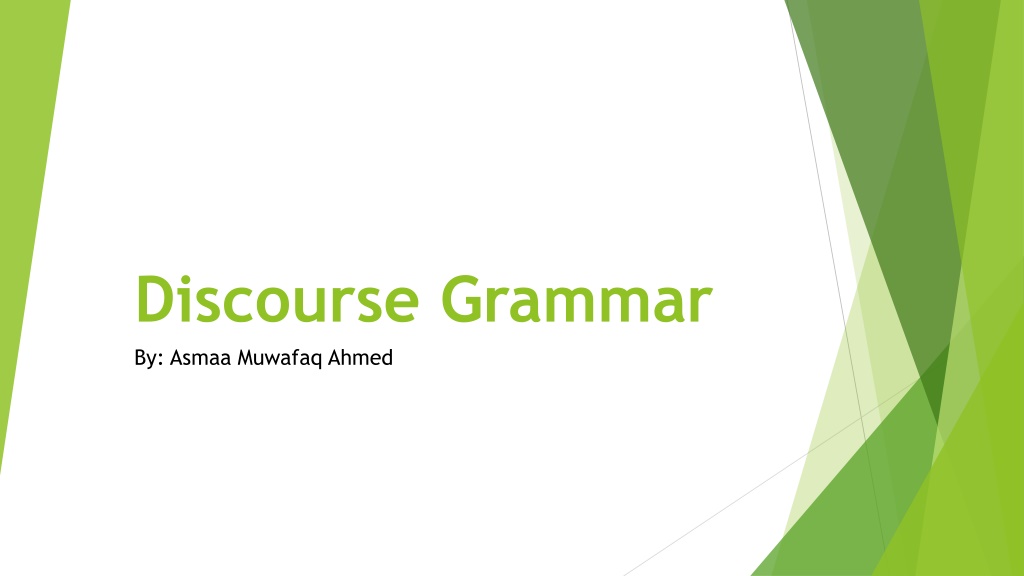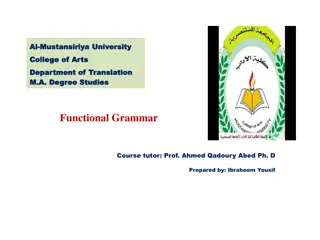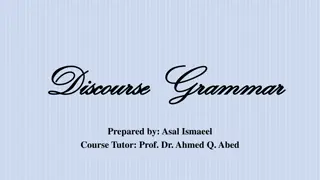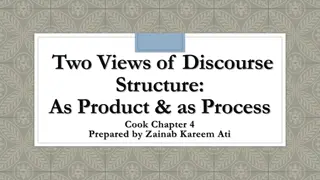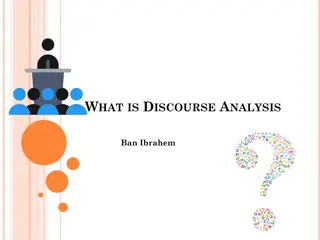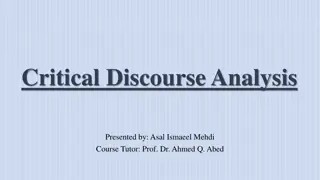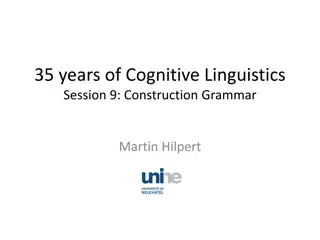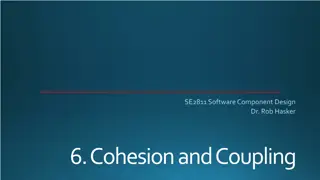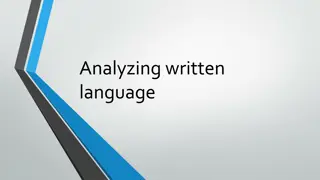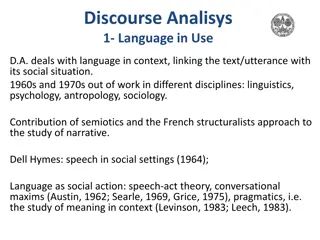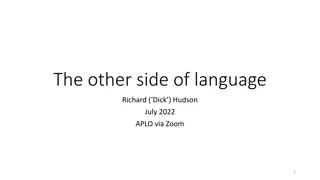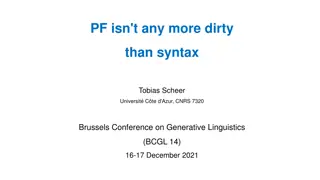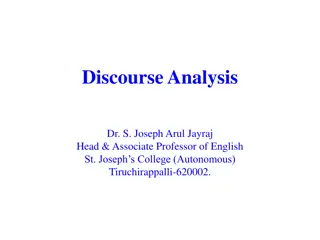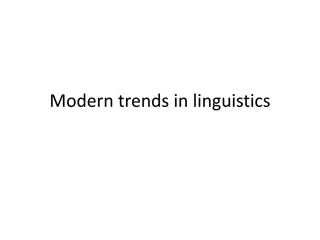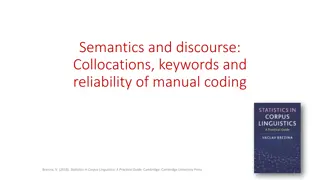Understanding Discourse Grammar and Cohesion in Linguistics
Explore the concepts of substitution, ellipsis, and cohesion in discourse grammar through examples and explanations. Discover how elements like nominal, verbal, and clausal substitutes, as well as ellipsis, play a vital role in creating cohesive patterns in language usage.
Download Presentation

Please find below an Image/Link to download the presentation.
The content on the website is provided AS IS for your information and personal use only. It may not be sold, licensed, or shared on other websites without obtaining consent from the author. Download presentation by click this link. If you encounter any issues during the download, it is possible that the publisher has removed the file from their server.
E N D
Presentation Transcript
Discourse Grammar By: Asmaa Muwafaq Ahmed
Substitution With substitution, a substitute form is used for another language item, phrase or group. Nominal Substitute: It can involve substituting an item for a noun. Try reading this book. The at one s not very good. Verbal substitute: It can involve substituting an item for a verb A: Has he had dinner yet? B: He must have done. There s no food in the fridge. Clausal substitute: An item may also substitute for a clause A: That s great to hear you re still happy. B: Oh yes very much so .
Ellipsis With ellipsis some essential element is omitted from the text and can be recovered by referring to a preceding element in the text. Ellipsis may involve the omission of a noun or noun group, a verb or verbal group or a clause. Announcer: Gary, what did you want to say to Allison tonight? Caller: [I want to say] that I m very sorry for the fight we had the other night. Announcer: What was that over? Caller: [It was over] something rather silly actually Announcer: They usually are, aren t they? Caller: Yeah [they usually are silly] and [I want to say] that I love her very much and [I want to say that] we ll have to stick it through, you know?
Differences between reference, ellipsis and substitution Reference can reach a long way back in the text whereas ellipsis and substitution are largely limited to the immediately preceding clause. With reference there is a typical meaning of co- reference. With ellipsis and substitution, this is not the case. There is always some difference between the second instance and the first.
Patterns of cohesion: A sample analysis Here is Edward Bear, coming downstairs now, bump, bump, bump, on the back of his head, behind Christopher Robin. It is, as far as he knows, the only way of coming downstairs, but sometimes he feels that there really is another way, if only he could stop bumping for a moment and think of it. And then he feels perhaps there isn t. Anyhow, here he is at the bottom, and ready to be introduced to you. Winnie-the- Pooh. When I first heard his name, I said, just as you are going to say, But I thought he was a boy?
Patterns of cohesion As Cook explains, referring expressions thus: fulfil a dual purpose of unifying the text: 1- they depend on some of the subject matter remaining the same and; 2- Of economy because they save us from having to repeat the identity of what we are talking about again and again.
Theme and rheme Two elements that contribute to the texture of a text: the relationship between theme and rheme in a clause and; its contribution to the focus and flow of information in a text. An understanding of this is important, especially for the writing of successful student texts.
Theme Theme is the element which serves as the point of departure of the message It also introduces information prominence into the clause. In below example, Genre is the theme and the rest of the sentence is its rheme. The theme in this sentence is a topical theme . Theme Rheme Genre is a term in widespread use to indicate an approach to communication which emphasizes social function and purpose.
2- Textual Theme Topical theme Textua l theme Topical theme Rheme Genre is a term in widespread use to indicate an approach to communication which emphasizes social function and purpose. surrounds the definition of genre, particularly the extent to which it refers to texts or activities in which texts are embedded. is often vaguely defined Significant debate It but Several uses of the term can be identified which are illustrated in different types of genre analysis. Above, an example of a textual theme can be seen in the final, where but joins two clauses together. The rest of the themes are topical themes.
3-Interpersonal Theme Interpersonal theme refers to an item that comes before the rheme which indicates the relationship between participants in the text, or the position or point of view that is being taken in the clause. Below is an example of a textual theme, an interpersonal theme and a topical theme. Here the interpersonal theme expresses uncertainty about the proposition that follows: Textual theme Interpersonal theme Topical theme Rheme However it seems unlikely that Descartes would deliberately challenge the church
Multiple theme The below extract shows a further example of textual, interpersonal (expresses presumption) and topical themes. It is an example of multiple theme . That is, there is more than a single thematic element in the Theme component of the clause. Textual theme Interpersonal theme of course, Topical theme Rheme Because, the dating game is a clumsy dance of blunders and misunderstandings
Thematic progression Thematic progressionrefers to the way in which the theme of a clause may pick up, or repeat, a meaning from a preceding theme or rheme. This is a key way in which information flowis created in a text. There a number of ways in which this may be done.
Constant theme One example of thematic progression is theme reiteration or constant theme. In this pattern, Theme 1 is picked up and repeated at the beginning of the next clause, signalling that each clause will have something to say about the theme.
Theme Rheme Text can be used for both spoken and written language. It usually refers to a stretch, an extract or complete piece of writing or speech Discourse is a much wider term. It can be used to refer to language in action, such as legal discourse, which has characteristic patterns of language.
Linear theme This is referred to as a zigzag or linear pattern theme. It is a common pattern of thematic progression in which the subject matter in the rheme of one clause is taken up in the theme of a following clause. Theme The term modality Rheme describes a range of grammatical resources used to express probability or obligation is used in speech, speech, especially when wanting to get things done such as You should keep your room tidy . Generally, obligation
Multiple theme/split rheme Texts may, equally, include other kinds of progression such as a multiple-theme or splitrheme patterns. In multiple-theme / splitrheme progression, a rheme may include a number of different pieces of information, each of which may be taken up as the theme in a number of subsequent clauses.
Theme Rheme When Japanese people write their language they use a combination of two separate alphabets as well as ideograms borrowed from Chinese are called hiragana and katakana. The two alphabets The Chinese ideograms are called Kanji. Hiragana represents the 46 basic sounds that are made in the Japanese language Katakana represents the same sounds as hiragana but (Katakana) is used mainly for words borrowed from foreign languages and for sound effects. Kanji are used to communicate an idea rather than a sound.
Attitude and grammar Attitude refers to resources used to make either a positive or negative evaluation of phenomena ; i.e. the ways in which writers and speakers evaluatively position themselves in relation to others, what they believe, how they feel, and what they believe that they know Appraisal theory divides Attitude into three main categories: affect , judgement and appreciation These categories are interconnected in that they are all motivated at some level with affectual response . These categories may be expressed either explicitly through the use of individual lexical items or implicitly through the process of implicature.
Attitude and grammar The division between affect , judgement and appreciation categories may, be fuzzy and not always be clear-cut. One appraisal value may be more dominant in a text than another and be a characteristic of a particular genre. Hard news stories, in English for example, may typically have a high level of intensity in the ways in which interpersonal values are expressed.
Attitude and grammar Australia s reaction to the Afghan boatpeople, in the wake of the appalling terrorist attacks in the US, will serve as a metaphor for the US and general Western response to the terrorist acts themselves. Nothing would be more foolish than to think it ssmart to keep out the Afghans because they are in some mysterious way linked to Islamic politics which, in its terrorist manifestation, produced Tuesday sterrible tragedy. That would be to blame the victims, par excellence
Attitude and grammar Attitude can also be graduated in terms of force . This can be done in two ways; 1- meanings can be graded in terms of intensity (intensification) For example, in the above extract terroristattacks is intensified by the use of appalling and tragedy is intensified by terrible . 2- meanings can be quantified (quantification). For example, the author writes There will likely be a big increase in the US military budget . Here, big quantifies the increase in the US military budget
Grammar and engagement Engagement is concerned with the sourcing of attitude and acknowledgement of alternative voices in a text. It is the way in which people intertexually position what they say Speakers may endorse what another person says, or they may distance themselves from what other people say. They may take responsibility for what they say, they may take no responsibility for what they say, or they may share some responsibility with the words or views of the person or source they are quoting. The main ways in which engagement is expressed is through attribution, modality and disclaimers and proclaimers.
Attitude and grammar Attribution is where someone refers to the words, views or thoughts of another source, or person to evaluate the material as being relevant. They may indicate support for the material (endorsement), by using for example, demonstrate . They may not support the material ( dis-endorsement ). by using for example, claim Or they may be neutral about the material ( non-endorsement ). by using for example, say They may nominalize reporting verbs by using items such as statement , demonstration and suggestion . They may also qualify a statement with an evaluative item such as controversial , unbiased or questionable . They may use modal items such as always , normally and possibly to express certainty, usuality or probability, for example, and to convey their position on the attributed material. The material may be directly quoted or it may be paraphrased; A speaker or writer may also disclaim or proclaim the source material, they may reject the outside source in order to replace it with something else, or they may present the material in such as way that it is difficult for someone else to challenge
Some critics have pointed out that Hes Just Not That into You s advice to women to let men do all the running is similar to The Rules, which infuriated women with its old-fashioned insistence on passive, compliant, female behaviour. Jen Abydeera agrees . It takes your power away and puts it all on the men s side. And it reinforces old gender stereotypes. It s OK for women to be proactive now, and I think that not only do men like it they expect it. - The source material is textually integrated, that is, assimilated - The source material is identified, singular and specific - The text expresses high affect - The text also, simultaneously, expresses high negative judgement.
Grammatical differences between spoken and written discourse There are a number of grammatical differences between spoken and written language which have implications for discourse analysis. These are not simple, clearcut boundaries but, rather, represent a continuum of differences between spoken and written discourse.
Grammatical intricacy and spoken and written discourse A commonly held view is that writing is more structurally complex and elaborate than speech. Halliday argues that speech is no less highly organized than writing and spoken discourse has its own kind of complexity. He presents the notion of grammatical intricacy to account for the way in which the relationship between clauses in spoken discourse can be much more spread out and with more complex relations between them than in writing.
Grammatical intricacy and spoken and written discourse The following extract by a judge on a television song competition contains sets of clauses that are long and spread out in the way that Halliday describes. The You are fabulous, truly, truly fabulous. And you know what s fabulous about you? I believe that the real, true artists, the people that are around for a long time, who touch people s lives, are those artists that have lots of contradictions within them, and you had many contradictions within you when you first rocked up. You looked like a skate punk and you had this aura of Don t mess with me about you, and, but every time you step in front of us you take another step towards being what we wanna create here, which is a superstar artist. That was a fantastic song for you. You just rocked the house and I can t believe they have got you in heels! Absolute class act, darling.
Lexical density in spoken and written discourse Written discourse tends to be more lexically dense than spoken discourse. Lexical density refers to the ratio of content words to grammatical or function words within a clause. Content words include nouns and verbs while grammatical words include items such as prepositions, pronouns and articles. In spoken discourse content words tend to be spread out over a number of clauses rather than being tightly packed into individual clauses which is more typical of written discourse.
Lexical density in spoken and written discourse The following extract illustrates the higher lexical density that is typical of many written texts , there are seven content words in each of the clauses. If Casablanca defined true love for a generation of incurable romantics, it also defined the aesthetic possibilities of cinema for a generation of film lovers
Nominalization and grammatical metaphor in written and spoken discourse There is a high level of nominalization in written texts; where actions and events are presented as nouns rather than as verbs, that is grammatical metaphor which is a phenomenon where a language item is transferred from a more expected grammatical class to another. Written texts typically include longer noun groups than spoken texts. This leads to a situation where the information in the text is more tightly packed into fewer words and less spread out than in spoken texts.
Nominalization and grammatical metaphor in written and spoken discourse The following extract from an analysis of Casablanca by Corliss illustrates this. Although Casablanca defines Bogey for all time as the existential-hero-in-spite-of-himself, several of his roles just preceding this one (notably High Sierra and The Maltese Falcon) had prepared his fans for the misanthropy and climatic selflessness he would embody as Rick Blaine. Bergman (as Ilsa Lund) and Henreid (as Victor Laszlo) are hardly incandescent lovers neither are Bergman and Bogart, for that matter but their turgidity as sexual partners works, intentionally or not, to the film s advantage.
Nominalization and grammatical metaphor in written and spoken discourse In the below extract, finish is an example of grammatical metaphor. It is an event that would be normally expressed as a verb but, here, is expressed as a noun Ilsa: Can I tell you a story , Rick? Rick: Has it got a wow finish ? Ilsa: I don t know the finish yet. Rick: Well, go on, tell it. Maybe one will come to you as you go along.
Nominalization and grammatical metaphor in written and spoken discourse grammatical metaphors include: Experiential metaphor: An example of an experiential metaphor is where something that would normally (or congruently) be expressed by a verb such as criticize is expressed by a noun, as in criticism . Interpersonal metaphor: that arises when an item such as perhaps that would congruently be expressed by a modal item is regrammaticised as a noun, as in possibility. In the example below: Casablanca . . . defined the aesthetic possibilities of cinema for a generation of film lovers, possibilities is an example of interpersonal metaphor.
A continuum of differences between spoken and written discourse It is argued that there is no simple, one-dimensional difference between spoken and written discourse. These differences are most usefully seen as being on a scale, or continuum: Some spoken texts may be more implicit whereas written texts may often be more explicit. There is also a scale of real time to lapsed time for spoken and (most) written discourse. Some texts are also more fragmented than others in their performance such as casual conversations. Other texts, such as prepared academic lectures may be more tightly organized and integrated.
Bibers corpus-based analyses Biber s corpus-based analyses of differences between spoken and written texts found that there is no single absolute difference between speech and writing in English, but rather dimensions of variation Biber s work supports this notion of a spoken written continuum. He demonstrates that there are no differences between spoken and written language in terms of the predominance of certain linguistic features. Biber shows that spoken and written language are multidimensional constructs with some spoken and written genres having a number of features in common with other spoken and written genres Biber points out how certain linguistic features may cluster in texts that share a similar communicative function. Spoken and written styles may intermingle with each other in that forms that are typically associated with spoken language may also occur in written language, such as in informal letters, email, etc.
